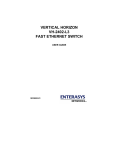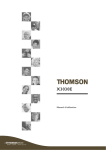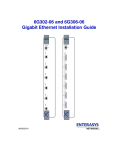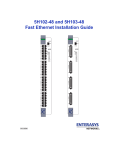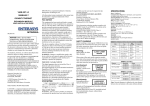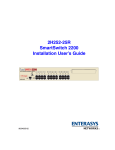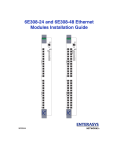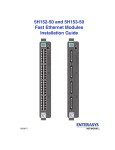Download Enterasys VH-8G-L3 User guide
Transcript
Vertical Horizon VH-8G-L3 Gigabit Ethernet Switch USER GUIDE 9033705-01 Notice ELECTRICAL HAZARD: Only qualified personnel should perform installation procedures. NOTICE Enterasys Networks reserves the right to make changes in specifications and other information contained in this document and its web site without prior notice. The reader should in all cases consult Enterasys Networks to determine whether any such changes have been made. The hardware, firmware, or software described in this document is subject to change without notice. IN NO EVENT SHALL ENTERASYS NETWORKS BE LIABLE FOR ANY INCIDENTAL, INDIRECT, SPECIAL, OR CONSEQUENTIAL DAMAGES WHATSOEVER (INCLUDING BUT NOT LIMITED TO LOST PROFITS) ARISING OUT OF OR RELATED TO THIS DOCUMENT, WEB SITE, OR THE INFORMATION CONTAINED IN THEM, EVEN IF ENTERASYS NETWORKS HAS BEEN ADVISED OF, KNEW OF, OR SHOULD HAVE KNOWN OF, THE POSSIBILITY OF SUCH DAMAGES. Enterasys Networks, Inc. 500 Spaulding Turnpike Portsmouth, NH 03801 2002 Enterasys Networks, Inc. All Rights Reserved Printed in Taiwan, R.O.C. Order Number: 9033705-01 March 2002 LANVIEW is a registered trademark of Enterasys Networks. ENTERASYS NETWORKS, NETSIGHT, MATRIX, WEBVIEW, and any logos associated therewith, are trademarks of Enterasys Networks. SPECTRUM is a registered trademark of Aprisma Management Technologies, Inc. All other product names mentioned in this manual may be trademarks or registered trademarks of their respective companies. 9033705-01 Notice FCC NOTICE This device complies with Part 15 of the FCC rules. Operation is subject to the following two conditions: (1) this device may not cause harmful interference, and (2) this device must accept any interference received, including interference that may cause undesired operation. NOTE:This equipment has been tested and found to comply with the limits for a class A digital device, pursuant to Part 15 of the FCC rules. These limits are designed to provide reasonable protection against harmful interference when the equipment is operated in a commercial environment. This equipment uses, generates, and can radiate radio frequency energy and if not installed in accordance with the operator’s manual, may cause harmful interference to radio communications. Operation of this equipment in a residential area is likely to cause interference in which case the user will be required to correct the interference at his own expense. WARNING:Changes or modifications made to this device which are not expressly approved by the party responsible for compliance could void the user’s authority to operate the equipment. INDUSTRY CANADA NOTICE This digital apparatus does not exceed the class A limits for radio noise emissions from digital apparatus set out in the Radio Interference Regulations of the Canadian Department of Communications. Le présent appareil numérique n’émet pas de bruits radioélectriques dépassant les limites applicables aux appareils numériques de la class A prescrites dans le Règlement sur le brouillage radioélectrique édicté par le ministère des Communications du Canada. VCCI NOTICE This is a class A product based on the standard of the Voluntary Control Council for Interference by Information Technology Equipment (VCCI). If this equipment is used in a domestic environment, radio disturbance may arise. When such trouble occurs, the user may be required to take corrective actions. 9033705-01 Notice CLASS A ITE NOTICE WARNING:This is a class A product. In a domestic environment this product may cause radio interference in which case the user may be required to take adequate measures. 9033705-01 Notice ENTERASYS NETWORKS, INC. PROGRAM LICENSE AGREEMENT BEFORE OPENING OR UTILIZING THE ENCLOSED PRODUCT, CAREFULLY READ THIS LICENSE AGREEMENT. This document is an agreement (“Agreement”) between You, the end user, and Enterasys Networks, Inc. (“Enterasys”) that sets forth your rights and obligations with respect to the Enterasys software program (“Program”) in the package. The Program may be contained in firmware, chips or other media. UTILIZING THE ENCLOSED PRODUCT, YOU ARE AGREEING TO BECOME BOUND BY THE TERMS OF THIS AGREEMENT, WHICH INCLUDES THE LICENSE AND THE LIMITATION OF WARRANTY AND DISCLAIMER OF LIABILITY. IF YOU DO NOT AGREE TO THE TERMS OF THIS AGREEMENT, RETURN THE UNOPENED PRODUCT TO ENTERASYS OR YOUR DEALER, IF ANY, WITHIN TEN (10) DAYS FOLLOWING THE DATE OF RECEIPT FOR A FULL REFUND. IF YOU HAVE ANY QUESTIONS ABOUT THIS AGREEMENT, CONTACT ENTERASYS NETWORKS (603) 332-9400. Attn: Legal Department. 1. LICENSE.You have the right to use only the one (1) copy of the Program provided in this package subject to the terms and conditions of this License Agreement. You may not copy, reproduce or transmit any part of the Program except as permitted by the Copyright Act of the United States or as authorized in writing by Enterasys. 2. OTHER RESTRICTIONS.You may not reverse engineer, decompile, or disassemble the Program. 3. APPLICABLE LAW.This License Agreement shall be interpreted and governed under the laws and in the state and federal courts of New Hampshire. You accept the personal jurisdiction and venue of the New Hampshire courts. 4. EXPORT REQUIREMENTS.You understand that Enterasys and its Affiliates are subject to regulation by agencies of the U.S. Government, including the U.S. Department of Commerce, which prohibit export or diversion of certain technical products to certain countries, unless a license to export the product is obtained from the U.S. Government or an exception from obtaining such license may be relied upon by the exporting party. If the Program is exported from the United States pursuant to the License Exception CIV under the U.S. Export Administration Regulations, You agree that You are a civil end user of the Program and agree that You will use the Program for civil end uses only and not for military purposes. 9033705-01 Notice If the Program is exported from the United States pursuant to the License Exception TSR under the U.S. Export Administration Regulations, in addition to the restriction on transfer set forth in Sections 1 or 2 of this Agreement, You agree not to (i) reexport or release the Program, the source code for the Program or technology to a national of a country in Country Groups D:1 or E:2 (Albania, Armenia, Azerbaijan, Belarus, Bulgaria, Cambodia, Cuba, Estonia, Georgia, Iraq, Kazakhstan, Kyrgyzstan, Laos, Latvia, Libya, Lithuania, Moldova, North Korea, the People’s Republic of China, Romania, Russia, Rwanda, Tajikistan, Turkmenistan, Ukraine, Uzbekistan, Vietnam, or such other countries as may be designated by the United States Government), (ii) export to Country Groups D:1 or E:2 (as defined herein) the direct product of the Program or the technology, if such foreign produced direct product is subject to national security controls as identified on the U.S. Commerce Control List, or (iii) if the direct product of the technology is a complete plant or any major component of a plant, export to Country Groups D:1 or E:2 the direct product of the plant or a major component thereof, if such foreign produced direct product is subject to national security controls as identified on the U.S. Commerce Control List or is subject to State Department controls under the U.S. Munitions List. 5. UNITED STATES GOVERNMENT RESTRICTED RIGHTS.The enclosed Product (i) was developed solely at private expense; (ii) contains “restricted computer software” submitted with restricted rights in accordance with section 52.227-19 (a) through (d) of the Commercial Computer Software-Restricted Rights Clause and its successors, and (iii) in all respects is proprietary data belonging to Enterasys and/or its suppliers. For Department of Defense units, the Product is considered commercial computer software in accordance with DFARS section 227.7202-3 and its successors, and use, duplication, or disclosure by the Government is subject to restrictions set forth herein. 6. EXCLUSION OF WARRANTY.Except as may be specifically provided by Enterasys in writing, Enterasys makes no warranty, expressed or implied, concerning the Program (including its documentation and media). ENTERASYS DISCLAIMS ALL WARRANTIES, OTHER THAN THOSE SUPPLIED TO YOU BY ENTERASYS IN WRITING, EITHER EXPRESS OR IMPLIED, INCLUDING BUT NOT LIMITED TO IMPLIED WARRANTIES OF MERCHANTABILITY AND FITNESS FOR A PARTICULAR PURPOSE, WITH RESPECT TO THE PROGRAM, THE ACCOMPANYING WRITTEN MATERIALS, AND ANY ACCOMPANYING HARDWARE. 7. NO LIABILITY FOR CONSEQUENTIAL DAMAGES.IN NO EVENT SHALL ENTERASYS OR ITS SUPPLIERS BE LIABLE FOR ANY DAMAGES WHATSOEVER (INCLUDING, WITHOUT LIMITATION, DAMAGES FOR LOSS OF BUSINESS, PROFITS, BUSINESS INTERRUPTION, LOSS OF BUSINESS INFORMATION, SPECIAL, INCIDENTAL, CONSEQUENTIAL, OR RELIANCE DAMAGES, OR OTHER LOSS) ARISING OUT OF THE USE OR INABILITY TO USE THIS ENTERASYS PRODUCT, EVEN IF ENTERASYS HAS BEEN ADVISED OF THE POSSIBILITY OF SUCH DAMAGES. BECAUSE SOME STATES DO NOT 9033705-01 Notice ALLOW THE EXCLUSION OR LIMITATION OF LIABILITY FOR CONSEQUENTIAL OR INCIDENTAL DAMAGES, OR IN THE DURATION OR LIMITATION OF IMPLIED WARRANTIES IN SOME INSTANCES, THE ABOVE LIMITATION AND EXCLUSIONS MAY NOT APPLY TO YOU. 9033705-01 Notice DECLARATION OF CONFORMITY Application of Council Directive(s): 89/336/EEC 73/23/EEC Manufacturer’s Name: Enterasys Networks, Inc. Manufacturer’s Address: 500 Spaulding Turnpike PO Box 3060 Portsmouth, NH 03801 European Representative Address: Enterasys Networks Ltd. Nexus House, Newbury Business Park London Road, Newbury Berkshire RG14 2PZ, England Conformance to Directive(s)/Product Standards: EC Directive 89/336/EEC EC Directive 73/23/EEC EN 55022 EN 55024 EN 60950 EN 60825 Equipment Type/Environment: Networking Equipment, for use in a Commercial or Light Industrial Environment. Enterasys Networks, Inc. declares that the equipment packaged with this notice conforms to the above directives. 9033705-01 Table of Contents PREFACE................................................................................ 3 Purpose.......................................................................... 3 Audience ....................................................................... 3 Conventions .................................................................. 3 Organization.................................................................. 4 PRODUCT OVERVIEW ....................................................... 6 Description.................................................................... 6 Layer 3 Switching ......................................................... 6 The Functions of a Layer 3 Switch ............................... 7 Features ......................................................................... 8 Ports .............................................................................. 8 Performance Features.................................................... 8 Layer 2 Features............................................................ 8 Layer 3 Switch Features................................................ 9 Traffic Classification and Prioritization...................... 10 Management................................................................ 10 Optional Redundant Power Supply............................. 11 Gigabit Ethernet Technology...................................... 11 Front Panel .................................................................. 12 Rear Panel ................................................................... 12 Side Panels .................................................................. 13 LED Indicators............................................................ 13 Feature Summaries...................................................... 14 Factory Defaults.......................................................... 17 2. INSTALLATION.............................................................. 20 1 9033705-01 Inspecting Your Shipment .......................................... 20 Installation................................................................... 20 Desktop or Shelf Installation ...................................... 21 Rack Installation ......................................................... 21 Power on ..................................................................... 22 Power Failure .............................................................. 22 3. CONNECTING THE SWITCH ...................................... 23 Switch to End Node .................................................... 23 Switch to Hub or Switch ............................................. 23 APPENDIX A. TECHNICAL SPECIFICATIONS........... 25 APPENDIX B. FLOW CONTROL..................................... 28 APPENDIX C. ACRONYMS AND ABBREVIATIONS .. 29 9033705-01 2 Preface Purpose This guide provides information about the features and applications of the Enterasys Networks Vertical Horizon VH-8G-L3 layer 3 switch. Audience This guide is intended for Ethernet Local Area Network (LAN) administrators and Management Information Systems (MIS) personnel with the following background: • Working knowledge of Ethernet LANs • Familiarity with Transmission Control Protocol/Internet Protocol (TCP/IP) and Simple Network Management Protocol (SNMP) Conventions This section describes the conventions used in this guide. Message Formats Two types of messages, identified by icons, appear in the text: A note informs you of special circumstances. A caution indicates the possibility of equipment damage 3 9033705-01 Keyboard Entries This guide uses the following conventions for keyboard entries: • When you read “enter”, type the text and press the [Enter] key. • Example: Enter the Gateway IP address and press the [Enter] key. • When you read “select”, highlight the menu item and press the [Enter] key. Other Conventions This guide uses the following typographical conventions: • Initial Caps selections. Menu titles and console • [Enter] Used to designate the Enter or Return key. • Courier font Screen messages and user prompts. • Selection Describes a user-configurable interface item. • Field Describes a read-only information item. Organization Chapter 1. Product Overview: Describes the features of the Switch, front and rear panel components and application examples. Chapter 2. Installation: Describes the content of your Switch shipment, lists site requirements, and provides 9033705-01 4 mounting instructions. Instructions for making connections and powering up the Switch are provided as well. Chapter 3. Connecting the Switch: This describes how to connect the VH-8G-L3 to your Ethernet network, including connecting the Switch to an end node and connecting the Switch to hub or switch. Appendix A. Technical Specifications: Provides a list of standards compliance and certifications as well as physical and operational specifications. Appendix B. Flow Control: Describes how the flow control features are used to provide a mechanism for protecting the Switch from overload conditions and to keep additional traffic off the network. Appendix C. Acronyms and Abbreviations: Provides definitions for a list of common acronyms and abbreviations used within the installation guide and the networking industry. 5 9033705-01 Product Overview This chapter provides the following information: • Product Description • Features • Front and Rear Panel Component Descriptions • Feature Summaries • Application Example Description This section describes Layer 3 functionality and Layer 2 and Layer 3 features of the VH-8G-L3. Some background information about Ethernet/Fast Ethernet, Gigabit Ethernet, and switching technology is presented. This is intended for readers who may not be familiar with the concepts of layered switching and routing but is not intended to be a complete or in-depth discussion. Layer 3 Switching Layer 3 switching is an integration of two proven technologies: switching and routing. In fact, Layer 3 switches are running the same routing routines and protocols as traditional routers. The main difference between traditional routing and Layer 3 switching is the addition of a group of Layer 2 switching domains and the execution of routing routines for most packets via an ASIC – in hardware instead of software. Where a traditional router would have one, or at best a few, Fast Ethernet ports, the VH-8G-L3 Layer 3 switch has 8 Gigabit Ethernet ports. 6 9033705-01 The VH-8G-L3 can be thought of as eight Gigabit Ethernet Layer 2 switching domains with a wire-speed router between each domain. It can be deployed in a network between a traditional router and the intranetwork. The traditional router and its associated WAN interface would then handle routing between the intranetwork and the WAN (the Internet, for example) while the Layer 3 switch would handle routing within the LAN (between the Fast Ethernet Layer 2 domains). The VH-8G-L3 can also replace key traditional routers for data centers and server farms, routing between these locations and the rest of the network, and providing 8 ports of Layer 2 switching performance combined with wire-speed routing. The Functions of a Layer 3 Switch Traditional routers, once the core components of large networks, became an obstacle to the migration toward nextgeneration networks. Attempts to make software-based routers forward packets more quickly were inadequate. A layer 3 switch does everything to a packet that a traditional router does: • Determines information • Validates the integrity of the Layer 3 header via checksum • Verifies packet expiration and updates accordingly • Processes and responds to any optional information • Updates forwarding statistics in the Management Information Base • Applies security controls forwarding path based on Layer 3 A Layer 3 switch can be placed anywhere within a network core or backbone, easily and cost-effectively replacing the 7 9033705-01 traditional collapsed backbone router. The VH-8G-L3 Layer 3 switch communicates with a WAN router using a standard Gigabit Ethernet port. Multiple VH-8G-L3 switches can also be linked. Features The VH-8G-L3 was designed for easy installation and high performance in an environment where traffic on the network and the number of users increase continuously. Switch features include: Ports • Six 1000BASE-SX (SC-type fiber transceiver). • Two GBIC-based Gigabit Ethernet ports. • RS-232 DCE Diagnostic port (console port) for setting up and managing the Switch via a connection to a console terminal or PC using a terminal emulation program. Performance Features Layer 2 Features • 16 Gbps switching fabric capacity. • Wire speed packet forwarding rate per system. • Store and forward switching scheme. • Auto-polarity detection and correction of incorrect polarity on the transmit and receive twisted-pair at each port. • IEEE 802.3z compliant. • IEEE 802.3x compliant Flow Control support. 9033705-01 8 • 8K active MAC address entry table per device with automatic learning and aging (10 to 9999 seconds). • 512 KB packet buffer per device. • Broadcast and Multicast storm filtering. • Supports Port Mirroring. • Supports Port Trunking – up to four trunk groups may be set up. One trunk group can have from two to eight ports. • 802.1D Spanning Tree support. • 802.1Q Tagged VLAN support – up to 63 User-defined VLANs per device (one VLAN is reserved for internal use). GVRP – (GARP VLAN Registration Protocol, where GARP represents a Generic Attribute Registration Protocol (GARP), support for dynamic VLAN registration. • 802.1p Priority support with 4 priority queues. • IGMP Snooping support. Layer 3 Switch Features 9 • Wire speed IP forwarding. • Hardware-based Layer 3 IP switching. • IP packet forwarding rate of 12 Mpps. • 2K active IP address entry table per device. • Supports RIP – (Routing Information Protocol) version I and II. • Supports IP version 4. • IGMP version 1 and 2 support (RFC 1112 and RFC 2236). IGMP can be globally enabled or disabled for all VLANs. 9033705-01 • Supports PIM Dense Mode (draft-ietf-pim-v2-dm-03.txt). • Supports DVMRP (draft-ietf-idmr-dvmrp-v3-09.txt). • Supports Username to IP address mapping. • Supports IP multi-netting. • Supports IP packet de-fragmentation. • Supports Path MTU discovery. • Supports 802.1D frame support. Traffic Classification and Prioritization • Based on 802.1p priority bits. • Based on IP source and destination addresses. • 4 priority queues. • Supports Port and MAC based priorities. Management • RS-232 console port for out-of-band management via a console terminal or PC. • Spanning Tree Algorithm Protocol for creation of alternative backup paths and prevention of network loops. • SNMP v.1 Agent. • Telnet remote control console. • Fully configurable either in-band or out-of-band control via SNMP based software. • Flash memory for software upgrades. This can be done in-band via TFTP or out-of-band via the console. 9033705-01 network 10 • Built-in SNMP management: Bridge MIB (RFC 1493) RMON MIB (RFC 1757) – 4 groups MIB-II (RFC 1213) Interface MIB ext. (RFC 2233) CIDR MIB (RFC 2096) – excluding the IP Forwarding Table. 802.1p MIB (RFC 2674). • Supports Web-based management. • TFTP support. • BOOTP support. • IP filtering on the management interface. • DHCP Client support. • DHCP Relay Agent. • Password enabled. Optional Redundant Power Supply The VH-8G-L3 Gigabit Ethernet Layer 3 Switch supports an optional Redundant Power Supply to provide automatic power supply monitoring and switchover to a redundant power supply in case of a failure in the VH-8G-L3’s internal power supply. Gigabit Ethernet Technology Gigabit Ethernet is an extension of IEEE 802.3 Ethernet utilizing the same packet structure, format, and support for CSMA/CD protocol, full duplex, flow control, and management objects, but with a tenfold increase in 11 9033705-01 theoretical throughput over 100Mbps Fast Ethernet and a one hundred-fold increase over 10Mbps Ethernet. Since it is compatible with all 10Mbps and 100Mbps Ethernet environments, Gigabit Ethernet provides a straightforward upgrade without wasting a company’s existing investment in hardware, software, and trained personnel. Front Panel The front panel of the Switch consists of LED indicators, an RS-232 communication port, two GBIC-based Gigabit Ethernet ports, and six 1000BASE-SX ports. Figure 1-1. Front panel view of the Switch • Comprehensive LED indicators display the status of the switch and the network (see the LED Indicators section below). • An RS-232 DCE console port for setting up and managing the switch via a connection to a console terminal or PC using a terminal emulation program. • Six Gigabit Ethernet ports (1000BASE-SX). • Two GBIC-based Gigabit Ethernet ports. Rear Panel The rear panel of the Switch consists of a slot for the optional Redundant Power Supply and an AC power connector. Figure 1-2. Rear panel view of the Switch 9033705-01 12 • The AC power connector is a standard three-pronged connector that supports the power cord. Plug-in the female connector of the provided power cord into this socket, and the male side of the cord into a power outlet. Supported input voltages range from 100 ~ 240 VAC at 50 ~ 60 Hz. Side Panels The right side panel of the Switch contains two system fans (see the top part of the diagram below). The left side panel contains heat vents. Figure 1-3. Side panel views of the Switch • The system fans are used to dissipate heat. The sides of the system also provide heat vents to serve the same purpose. Do not block these openings, and leave at least 6 inches of space at the rear and sides of the Switch for proper ventilation. Be reminded that without proper heat dissipation and air circulation, system components might overheat, which could lead to system failure. LED Indicators The LED indicators of the Switch include Power, Link/Act, and RDP in use. The following shows the LED indicators for the Switch along with an explanation of each indicator. 13 9033705-01 Figure 1-4. The LED indicators • Power This indicator on the front panel will light green approximately 2 seconds after the Switch is powered on to indicate the ready state of the device. The LED will blink green while downloading new software for the Switch, or if the system’s configuration has changed and will light yellow when an error occurs. • Link/Act These indicators are located to the left of each port. They are lit when there is a secure connection (or link) to a device at any of the ports. The LEDs blink whenever there is reception or transmission (i.e. Activity--Act) of data occurring at a port. • RDP in use This indicator is lit when the optional Redundant Power Supply is being used. Feature Summaries The following summaries describe VH-8G-L3 features in areas such as standards compliance, functionality, performance, and options. Local Console Management A local console is a terminal or a workstation running a terminal emulation program that is connected directly to the Switch via the RS-232 console port on the front of the Switch. A console connection is referred to as an ‘Out-ofBand’ connection, meaning that console is connected to the switch using a different circuit than that used for normal network communications. So, the console can be used to set up and manage the Switch even if the network is down. Local console management uses the terminal connection to operate the console program built-in to the Switch. A 9033705-01 14 network administrator can manage, control and monitor the switch from the console program. The VH-8G-L3 contains a CPU, memory for data storage, flash memory for configuration data, operational programs, and SNMP agent firmware. These components allow the switch to be actively managed and monitored from either the console port or the network itself (out-of-band, or in-band). SNMP Management The Simple Network Management Protocol (SNMP) is an OSI layer 7 (the application layer) protocol for remotely monitoring and configuring network devices. SNMP enables network management stations to read and modify the settings of gateways, routers, switches, and other network devices. SNMP can be used to perform many of the same functions as a directly connected console, or can be used within an integrated network management software package such as NetSight. Flow Control The VH-8G-L3 supports flow control (back pressure handling) on a per-port basis. The limit at which flow control is applied to a port is based on the amount of memory used by the packets on an input port. • 802.3x Flow Control – if the port is configured in full duplex mode, a MAC PAUSE packet is sent to inhibit the flow of packets to the port for a short amount of time. Spanning Tree Protocol The VH-8G-L3 switch complies with the IEEE 802.1D Spanning Tree Protocol standard and allows for the blocking of links between switches that form loops within the network. When multiple links between switches are detected, a primary link is established. Duplicated links are blocked from use and become standby links. The protocol allows for the duplicate links to be used in the event of a failure of the 15 9033705-01 primary link. Once the Spanning Tree Protocol is configured and enabled, primary links are established and duplicated links are blocked automatically. The reactivation of the blocked links (at the time of a primary link failure) is also accomplished automatically – without operator intervention. Port Trunking Port trunking is used to combine a number of ports together to make a single high-bandwidth data pipeline. The participating ports are called members of a port trunking group, with one port designated as the master port of the group. Since all members of the port trunking group must be configured to operate in the same manner, the configuration of the master port is applied to all members of the port trunking group. Thus, when configuring the ports in a port trunking group, you only need to configure the master port. The VH-8G-L3 supports 4 port trunking groups, which may include from 2 to 8 switch ports each. IEEE 802.1Q VLANs IEEE 802.1Q (tagged) VLANs are implemented on the VH-8G-L3. 802.1Q VLANs allow tagging, which enables them to span the entire network (assuming all switches on the network are IEEE 802.1Q-compliant). IEEE 802.1Q VLANs also allow for dynamic VLAN registration using GVRP. VLANs allow a network to be segmented in order to reduce the size of broadcast domains. All packets entering a VLAN will only be forwarded to the stations (over IEEE 802.1Q enabled switches) that are members of that VLAN, and this includes broadcast, multicast and unicast packets from unknown sources. VLANs can also provide a level of security to your network. IEEE 802.1Q VLANs will only deliver packets between stations that are members of the VLAN. Broadcast Storm Control 9033705-01 16 Broadcast storms consist of broadcast packets that flood and/or are looped on a network causing noticeable performance degradation and in extreme cases, network failure. Broadcast storms can be caused by malfunctioning NICs, bad cable connections and applications or protocols that generate broadcast traffic, among others. Broadcast storms have long been a concern for network administrators with routers traditionally being used to prevent their occurrence, and if that failed, limit their scope. However, with the advent of VLANs, switches are now able to limit broadcast domains better and cheaper than routers. The VH-8G-L3 has broadcast sensors and filters built into each port to control broadcast storms. IP Routing IP is responsible for getting packets to the destination specified in the destination address. The task of determining how to get a packet from the source to the destination is referred to as routing. The VH-8G-L3 allows the creation of IP subnets and can perform IP routing between them. Each IP subnet corresponds to an IEEE 802.1Q VLAN, previously defined on the Switch. Factory Defaults Table 1-1 lists the default settings for the Switch configuration parameters. Each parameter can be changed via the console menus or Telnet. Parameter Default Value Load Mode Ethernet Switch Operation Mode Layer 2 Configuration Update Disabled Firmware Update Disabled 17 9033705-01 Configuration File Name None Firmware File Name None Out-Of-Band Baud Rate 9600 RS232 Mode Console IP Address 0.0.0.0 Subnet Mask 0.0.0.0 Default Gateway 0.0.0.0 BootP Service Enabled TFTP Server IP Address 0.0.0.0 IGMP Time Out 260 secs IGMP Disabled Partition Mode Enabled Address table lock Disabled Device HOL Disabled Port HOL Enabled Console Time Out 15 min User Name Admin Password None Device STA Enabled Port Enable Enabled Bridge Max Age 20 secs Bridge Hello Time 2 sec Bridge Forward Delay 15 sec Bridge Priority 32768 Device STA Cost For A 10 Mbps Port 100 Device STA Cost For A 100 Mbps Port 19 Device STA Cost For A 1000 Mbps Port 4 Device STA Priority 128 Forwarding Table Aging Time 300 secs Address Lookup Mode Level 1 Auto-Negotiation Enabled Flow Control Disabled 9033705-01 18 Backpressure Disabled Port Lock Disabled Broadcast Storm Rising Action Do Nothing Broadcast Storm Falling Action Do Nothing Broadcast Storm Rising Threshold 128Kpps Broadcast Storm Falling Threshold < 128Kpps Community String “public”, “private” VLAN Mode IEEE 802.1Q Management In A VLAN All SNMP VLAN(802.1Q) 1 Default Port VID 1 Ingress Rule Checking Disabled Mirror Src Port <->Target Port 1 2 Port Mirroring Disabled DVMRP (L3 Mode Only) Disabled PIM Dense Mode (L3 Mode Only) Disabled Table 1-1. Factory Default Settings 19 9033705-01 2. Installation Inspecting Your Shipment Open the shipping carton of the Switch and carefully unpack its contents. The carton should contain the following items: • One VH-8G-L3 8-port Gigabit Ethernet Layer 3 Switch. • Mounting kit: 2 mounting brackets and screws. • Four rubber feet with adhesive backing. • One AC power cord. • One ESD wrist strap. • Product Documentation. If any item is found missing or damaged, please contact your local Enterasys sales agent for replacement. Installation Use the following guidelines when choosing a place to install the Switch: • The surface must support at least 3 kg. • The power outlet should be within 1.82 meters (6 feet) of the device. • Visually inspect the power cord and see that it is secured to the AC power connector. • Make sure that there is proper heat dissipation from and adequate ventilation around the Switch. Do not place heavy objects on the Switch. 9033705-01 20 Desktop or Shelf Installation When installing the Switch on a desktop or shelf, the rubber feet included with the device should first be attached. Attach these cushioning feet on the bottom at each corner of the device. Allow adequate space for ventilation between the device and the objects around it. Figure 2-1. Installing rubber feet for desktop installation Rack Installation The VH-8G-L3 can be mounted in an EIA standard-sized, 19-inch rack, which can be placed in a wiring closet with other equipment. To install, attach the mounting brackets on the switch’s side panels (one on each side) and secure them with the screws provided. Figure 2- 2A. Attaching the mounting brackets Then, use the screws provided with the equipment rack to mount the Switch on the rack. 21 9033705-01 Figure 2-2B. Installing the Switch on an equipment rack Power on The VH-8G-L3 can be used with AC power supply 100-240 VAC, 50 - 60 Hz. Simply connect the power cord to the AC power connector located on the rear panel of the Switch and to AC power outlet. The Switch’s power supply will then adjust to the local power source automatically and may be started without having any or all LAN segment cables connected. After the AC power is connected, the LED indicators should respond as follows: • The Power LED indicator will remain steady while the Switch loads onboard software and performs a selftest. • When linked with the redundant power supply, the “RDP in use” LED will blink orange. Power Failure As a precaution in the event of a power failure, unplug the Switch. When power is resumed, plug the Switch back in. 9033705-01 22 3. Connecting The Switch This chapter describes how to connect the VH-8G-L3 to your Ethernet network. Switch to End Node A PC can be connected to the Switch via a fiber optic cable. The PC can be connected to any of the eight ports of the Switch. Figure 3-1. Example of the Switch connected to a PC or Workstation The LED indicators for the port the end node is connected to are lit according to the capabilities of the NIC. If LED indicators are not illuminated after making a proper connection, check the PC’s LAN card, the cable, switch conditions, and connections. The following LED indicator state is possible for an end node to switch connection: The Link/Act LED indicator lights up upon hooking up a PC that is powered on. Switch to Hub or Switch The Switch can be connected to another switch or other devices (routers, bridges, etc.) via a fiber optic cable. 23 9033705-01 Figure 3-2. Example of Switch to switch connection 9033705-01 24 Appendix A. Technical Specifications General Standards: IEEE 802.3z 1000BASE-SX Gigabit Ethernet IEEE 802.1 P/Q VLAN IEEE 802.3x Full-duplex Flow Control ANSI/IEEE 802.3 auto-negotiation Protocols: Data Transfer Rates: Gigabit Ethernet Topology: CSMA/CD Half-duplex Full-duplex n/a 2000Mbps Star Network Cables: Fiber Optic: IEC 793-2:1992 Type A1a - 50/125um multimode Type A1b - 62.5/125um multimode Use SC optical connector Number of Ports: 8 Gigabit Ethernet (including 2 GBIC-based) Physical and Environmental AC inputs: Power Consumption: DC fans: Operating Temperature: 9033705-01 100 - 240 VAC, 50/60 Hz (internal universal power supply) 40 watts maximum 4 built-in 40 x 40 x10 mm fans 0 to 40 degrees Celsius 25 Storage Temperature: Humidity: Dimensions: Weight: EMI: -40 to 70 degrees Celsius Operating: 10% to 85% RH non-condensing 441 mm x 210 mm x 43 mm (1U), 19 inch rack-mount width 2.61 kg FCC Class A, CE Class A, VCCI Class A, BSMI Class A, C-Tick Class A FCC Part 15/IECES-003 (Canada), VCCI Class A ITE, EN55022/EN50082-1 or EN%%o24, C-Tick (AS/NZS3548, BSMI (CNS 13438) Safety: UL/CUL, TUV/GS UL 1950 & CSA22.2 No 950, IEC 950 (CB), TUV (EN60950) 9033705-01 26 Performance Transmission Method: Store-and-forward RAM Buffer: 16 MB per device Filtering Address Table: 8K MAC address per device Packet Filtering/ Forwarding Rate: Full-wire speed for all connections 1,488,000 pps per port (for 1000Mbps) MAC Address Learning: Forwarding Table Age Time: 27 Automatic update. Max age:10–9999 seconds Default = 300. 9033705-01 Appendix B. Flow Control Flow control is a mechanism that allows you to protect the switch from overload conditions and to keep additional traffic off the network when excessive congestion will result. Flow Control for Half- and Full-Duplex Applications Each port of the switch has a transmit queue which buffers frames to be sent out on that port. In this example, large amounts of data are being sent from Workstation A (connected to port X) and other ports on the switch to Workstation B (connected to port Y). The queue on port Y starts filling up with data until it reaches a determined threshold. The packet that causes the threshold to be exceeded triggers the flow-control function on the port from which the packet entered the switch, in this case port X. Since port X is configured with flow control set to Enabled, the switch responds by initiating a pause frame (full-duplex applications) or back-pressure mechanism (half-duplex applications). The pause frame causes Workstation A to stop sending packets. After a certain amount of time has elapsed, determined by a value in the pause frame, Workstation A will resume sending data. Similarly, the back-pressure mechanism forces Workstation A to stop sending packets by inducing collisions on port X. The pause-frame flow-control mechanism supported by the VH-8G-L3 conforms with the IEEE 802.3x specification for full-duplex flow control. For the full-duplex pause-frame mechanism to work, the device connected to the switch port must also support IEEE 802.3x flow control. Flow control is configurable per port in the Configure Ports screen of the console menu, using the on-board Web agent, or via SNMP. 28 9033705-01 Appendix C. Acronyms and Abbreviations Term Definition 10BASE-T 10 Mbps twisted-pair Ethernet 100BASE-TX 100 Mbps twisted-pair Fast Ethernet 100BASE-FX 100 Mbps fiber option Fast Ethernet 1000BASE-T 1000 Mbps twisted-pair Gigabit Ethernet 1000BASE-SX 1000 Mbps fiber option short-wavelength Gigabit Ethernet 1000BASE-LX 1000 Mbps fiber option long-wavelength Gigabit Ethernet ANSI American National Standards Institute BootP Bootstrap Protocol CAT5e Category 5e Ethernet wiring standard CRC Cyclic Redundancy Check CSMA/CD Carrier Sense Multiple Access/Collision Detection DCE Data Communications Equipment (modem) DSR Data Send Ready DTE Data Terminal Equipment DTR Data Terminal Ready ESD Electrostatic Discharge FCS Frame Check Sequence HTTP Hypertext Transfer Protocol ICMP Internet Control Message Protocol IEEE Institute of Electrical and Electronics Engineers IP Internet Protocol LAN Local Area Network LED Light Emitting Diode MAC Media Access Control 9033705-01 29 MDI Media Dependent Interface MDI Media Device Interface MIB Management Information Base RFC Request for Comment RMON Remote Monitoring RXD Receive Data.38 SNMP Simple Network Management Protocol TCP/IP Transmission Control Protocol/Internet Protocol TFTP Trivial File Transfer Protocol TXD Transmit Data UTP Unshielded Twisted Pair VLAN Virtual LAN 9033705 30 Index AC inputs................................ 25 MAC Address Learning.......... 27 AC power cord........................ 20 Management............................ 10 Accessory pack ....................... 20 Master port.............................. 16 Auto polarity detection ............. 8 MIB-I (RFC 1156) .................. 11 Bridge MIB (RFC 1268)......... 11 MIB-II (RFC 1213)................. 11 Broadcast domains.................. 16 Operating Temperature ........... 25 Broadcast storms..................... 17 Power ...................................... 14 Connections Power Consumption................ 25 Switch to End Node ........... 23 RAM Buffer............................ 27 Switch to Hub or Switch .... 23 Rear Panel......................... 12, 13 Console port........................ 8, 12 RS-232 ...................................... 8 Diagnostic port.......................... 8 Security ................................... 16 Dimensions ............................. 26 Setup ....................................... 20 End Node ................................ 23 Spanning Tree Algorithm ....... 10 Flash memory ......................... 10 Storage Temperature............... 26 Front Panel.............................. 12 Store and forward switching ..... 8 Gigabit Ethernet...................... 11 Transmission Methods ............ 27 Humidity................................. 26 Trunk group ............................ 16 IEEE 802.1Q tagging.............. 16 Unpacking............................... 20 LED Indicators........................ 13 Weight..................................... 26 9033705-01 31









































